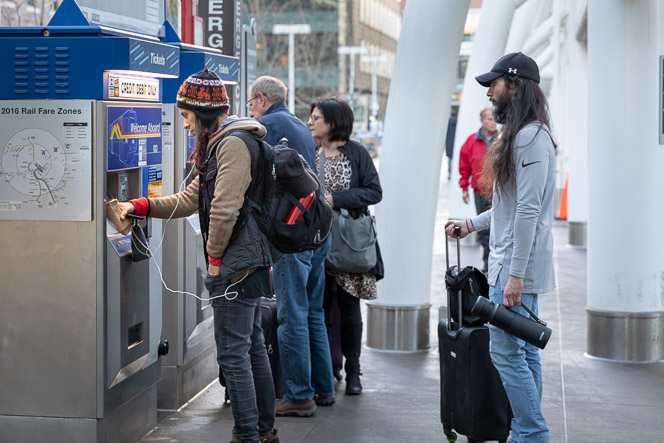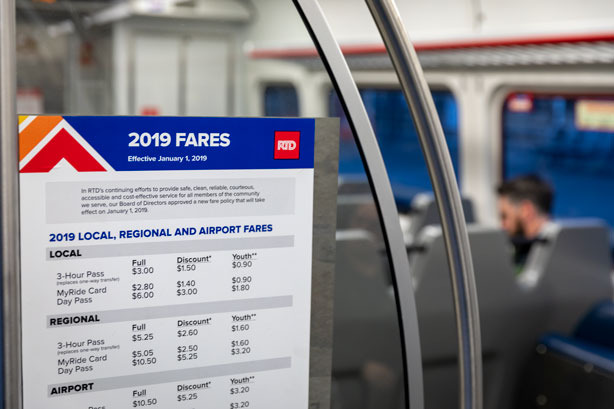Are RTD’s High Fares Bad for Denverites? (Yes and No)
Guest commentary: RTD may have the highest fares in the nation, but a nuanced comparison to other cities shows the benefits and drawbacks of the new fare structure's

This opinion piece responds to last week’s Streetsblog story: Denver’s New Bus and Train Fares Are the Most Expensive in the Nation.
RTD’s fares just went up, and they are high. An adult cash ticket with local service is now $3.00, up from $2.60, making RTD’s fare one of the highest across the country. But how RTD’s fares stack up to other transit systems depends on how you measure them.
Fare structures, not just the price of a one-way fare, can significantly affect how riders use the system. There is more to making transit work than just making it affordable, and how you ride can determine whether or not it’s affordable.
Fares can affect how useful transit Is
Transit is not at all useful if you can’t afford to ride it. However, just because transit is affordable does not mean it is useful. And sometimes, what your fare does or doesn’t buy you affects how useful your transit is.
Since I’m a visual learner, I’ll be referring to a hypothetical city with three transit lines (the red, blue, and green lines) and a person who wants to travel from point A to point B.
It shouldn’t matter if you ride a train or a bus
Useful, affordable transit does not discriminate by mode: It shouldn’t be more expensive if you need to go somewhere on a train line instead of a bus route. Transit agencies shouldn’t punish you for using what’s available and makes the most sense for you.
Fare structures shouldn’t penalize transfers
Good transit travels in straight lines between well-spaced stops instead of using winding routes with extraneous stops at out-of-the-way destinations. Routes that travel in straight lines inherently require more transfers between routes. Such systems that form a grid (like Denver’s) should allow a window of time for transfers, even where the frequency is poor (like Denver).

Back to our hypothetical city, transit routes like the blue and red lines can move people faster than circuitous routes like the green route. For a person going from A to B, it’s likely that riding the red route to the blue route will be more convenient than riding the green route. If transfers are free in the city, then a person can make the trip on the red and blue lines for the same price as making the trip on the green route. If the city does not have free transfers, then the rider will be penalized for using the route that makes more sense.
You should have enough time to get where you’re going
If your city has very slow-moving transit with long waits for transfers, you shouldn’t be the one paying for the time the transit agency made you wait. A person traveling from point A to point B should have enough time to get to point B without paying more.
How do RTD’s fares compare to other cities?
In Streetsblog’s article published last week, editor Andy Bosselman compared RTD’s new fares to those in thirteen other cities of similar size or larger than Denver. He concludes that RTD’s adult fare is the highest, and is more expensive than cities like New York and San Francisco where the cost of living is higher.
I used these thirteen cities as jumping points for my analysis. For comparison, I look at the full-price local fare for adults paying with cash. Many systems, including RTD’s, provide discounts for paying with smart cards or mobile apps. To make an apples-to-apples comparison, I am only using the cash fare.
Cost of local cash Fare
My fare data looks a little different than Streetsblog Denver’s data. First, New York MTA costs $3.00 for a single ride ticket. Second, for the reasons discussed above, I am skeptical of any analysis that compares RTD’s train and bus fare to a ticket that only includes bus service. My analysis thus compares fifteen fares, with the addition of Boston MBTA’s subway fare and Chicago CTA’s train fare. My chart that compares fares still looks a lot like Streetsblog’s chart, supporting the conclusion that Denver has a very high fare.
Fare cost including transfers
Allowing people to make transfers, and not penalizing transfers, makes for better transit. Yet transfers barely get a mention from Streetsblog, with a small note toward the end that riders will have three hours on one fare. If we consider the cost of making at least one transfer, prices begin to look a little different. Some transit systems, like RTD, do not charge for transfers. Other systems charge a small fee. Still, other systems require riders to buy another full-price fare each time they transfer lines.
Taking into account the cost of making one transfer, RTD still sticks out as expensive. However, it begins to look more reasonable, and systems that looked low-cost like Phoenix Metro and DC Metrobus, suddenly look quite expensive.
Amount of travel timex on one fare
The amount of time included in a single fare is another way to measure the value of a ticket. Many people can run errands within the three-hour window that a $3.00 RTD fare will buy. For comparison, riders of San Francisco’s Muni pay $2.75 and have only 90 minutes to make their trip. In the chart below, I refer to the amount of time that you buy with a single fare as your utility. In a system like Denver’s, you pay more, but you get a high amount of utility.
How to make RTD’s fares fairer
Even in my more nuanced analysis, Denver rises to the top of the pack as a costly system for riders. However, an RTD ticket will buy you more than in many other cities. In the pursuit of making RTD’s prices fairer in the future, activists and advocates will have to consider the possible trade-offs of fare prices and how useful the service they pay for is to riders. Utility should not be thrown out for lower fares.
What should stay the same
Advocates should ensure that future fare restructuring keeps free transfers, adequate time to transfer in any direction and price parity between modes. They should also ensure that RTD’s new discount fare program stays intact to serve youth and low-income residents.
What should change
RTD’s new 40 percent discounted fare for people living at or below 185 percent of the federal poverty level will not roll out until July. This six-month lag between the fare hike and new fare discounts is unconscionable and should never be allowed to happen again.
$3.00 is a very high price to pay for some residents living in Denver’s urban core. You can get pretty far on a local pass, but if you don’t need to go that far, there should be a way to pay less.
What could change
RTD could reform the new discount program in two ways. First, they could increase the discount available to low-income riders beyond the current 40 percent. They could also redefine who is considered low income to include more people.
You have a say!
The good news in all of this is that an elected board of fifteen representatives passed RTD’s new fare structure—and those board members are accountable to you. That means that every four years you have the power to vote for someone who aligns with your transit values. Bonus: If you think RTD needs to continue reforming their fare structure, you can find and contact them on RTD’s website.
Jamie Perkins is a board member emeritus of Streetsblog Denver. In 2018 she ran for the Regional Transportation District’s board of directors and in 2017 she earned a master’s in public policy from the University of Denver.
A version of this story was originally published on Perkins’ LinkedIn page. Follow her on Twitter at @perkja.
Streetsblog Denver welcomes opinion pieces and stories from our readers. If you would like to submit a idea for an editorial or story, e-mail andy@streetsblog.org.







